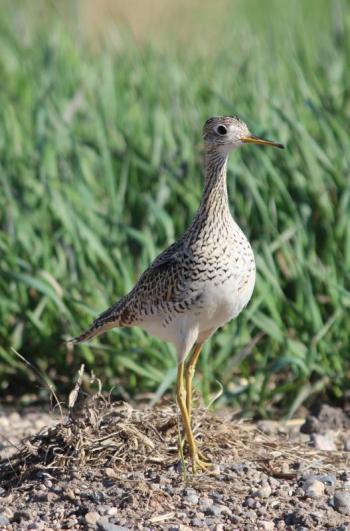Birding the Grasslands: Our Mindfulness Birding Big Year Update
In last week’s column, we described our Father’s Day trek to the Orono Bog, in an unsuccessful search for a Lincoln’s sparrow as we continue our Maine mindfulness Big Year. The quest for that sparrow jolted us into thinking about which other species we need to be mindful of this time of year, as late June moves into July.
Now that we are in the midst of the breeding season, we can no longer expect to see migrant species just about anywhere. Birds have settled into their preferred habitats to establish territories, build their nests, and raise their young. (Hopefully many of you are participating again this year in the Maine Breeding Bird Atlas that takes advantage of this point in the life cycle of birds, as a way to create an inventory of what species are breeding in the state and where they occur.)
During the breeding season, in order to add species to our list, we must seek out particular habitats as we did for the Lincoln’s sparrow. On that order, we also made an unsuccessful trip to listen for the burry song of the yellow-throated vireo at our favorite spot in Monmouth (as we wrote about in a past column). A major disappointment for us has been the many large hayfields we’ve checked in our area that are apparently devoid of the sweet, whistled songs of the eastern meadowlark. This species was formerly pretty common across much of Maine (at least the southern half of the state). We have stopped and listened at many locations where we used to find them. But sadly, they are not there anymore. In fact, meadowlarks are one of a suite of grassland birds that are showing rapid declines across much of their North America range, particularly here in Maine.
But some of our forays have been more joyous.
During an impromptu morning recently we stopped at the former Brunswick Naval Air Base and heard that distinctive series of long whistles—the song of the eastern meadowlark—floating in on the breeze from somewhere across the grasslands that surround the runways. It was too far away to see, but still, it was a beautiful sound to hear after finding that this distinctive music was gone from so many other grasslands.
While basking in that long-awaited song, another increasingly rare grassland bird song drifted in—the long “whoop-wheer” wolf whistle of a displaying male upland sandpiper. At first the song was barely audible; either the bird was flying very high in his display or was far off to the south (or both) but over time he must have moved closer. Regardless, he was seemingly invisible as he sang and displayed from high up in that bright, blue sky.
Upland sandpipers are amazing birds. They travel each year from their breeding grounds in the grasslands of North America south to the Pampas grasslands of southern South America and back again. Here in Maine, there are now only a handful of locations where they still nest. And it was good to know that one of them, the grasslands of the former base in Brunswick, still hosted at least a few.
This was a good day, one that made us mindful of how special so many of our birds are and the conservation challenges that we must take on if we want to them to be around for our kids and grandkids to see and enjoy.
As we write this, our Maine Big Year list stands at 188 species. More birds await us!
Jeffrey V. Wells, Ph.D., is a Fellow of the Cornell Lab of Ornithology. Dr. Wells is one of the nation's leading bird experts and conservation biologists and author of “Birder’s Conservation Handbook”. His grandfather, the late John Chase, was a columnist for the Boothbay Register for many years. Allison Childs Wells, formerly of the Cornell Lab of Ornithology, is a senior director at the Natural Resources Council of Maine, a nonprofit membership organization working statewide to protect the nature of Maine. Both are widely published natural history writers and are the authors of the book, “Maine’s Favorite Birds” and “Birds of Aruba, Bonaire, and Curaçao: A Site and Field Guide” from Cornell Press.






























